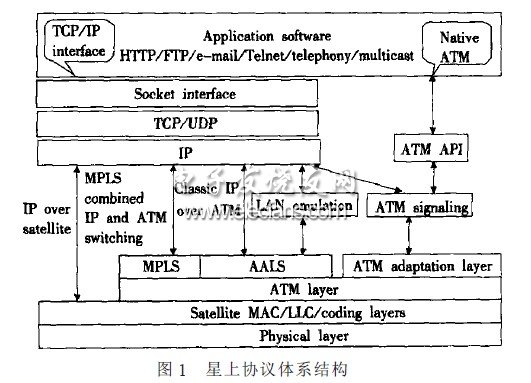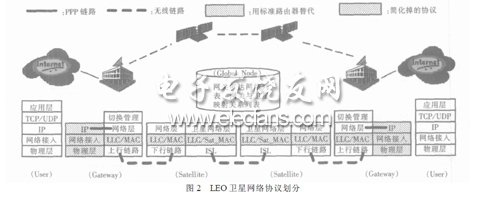introduction An important part of the future global communication system is the low-orbit satellite network communication system. Due to the long period of establishment and huge investment of the low-orbit satellite communication system, once it is built, it is not easy to change the system and other characteristics, it must be accurately simulated and verified before the system is implemented. OPNET is a network simulation software with excellent performance. It can design, model, analyze, and manage network structures, devices, and applications. It can meet the simulation needs of large and complex networks and has certain advantages in network layer protocol simulation. However, although OPNET provides a wealth of standard node models, link models, protocol modules, etc., it does not provide any low-orbit satellite standard modules, which brings certain difficulties to the simulation of low-orbit satellite network protocols. At present, some low-orbit satellite simulations based on OPNET mostly connect land network nodes with wired links. By discretizing the connection and disconnection of wired links, they can approximate the handover and topology changes in low-orbit satellite networks. This method requires complex calculations for specific low-orbit satellite networks before simulation, and it is not universal. By analyzing the structure of the low-orbit satellite protocol architecture, the article simplifies some parts of the protocol system, and implements a low-orbit satellite network protocol simulation platform on OPNET. This platform supports the development of routing protocols for non-face-to-face networks. Finally, the dynamic routing protocol is loaded on the simulation platform to verify the simulation platform. 1 Satellite communication system protocol architecture There are many kinds of network structures adopted according to different satellite communication system designs (orbit type, on-board processing or elbow, ISL design method). According to the current development trend of low-orbit satellite communications, this paper mainly studies low-orbit satellite networks with on-board processing / on-board switching (OBP / OBS) and inter-satellite link (ISL) support. Figure 1 shows the relationship between ATM and IP in the on-board protocol. Most early broadband IP satellite systems used ATM-based transmission technology. However, some researchers believe that the IP over Satellite solution has greater benefits than the IP over ATM solution: (1) The overhead is small. Bell laboratory simulation shows that if the structure of IP over ATM over SONET is adopted, there is about 22% to 29% of the overhead, and the SONET overhead is about 4%. Therefore, removing the ATM layer will make the on-board resources more fully utilized. (2) It is easy to implement a Gigabit packet network. At present, the experimental trunk rate of multimedia satellites using ATM technology has reached 622Mbps. However, when it is upgraded to Gigabit, the shortcomings of large overhead of ATM restrict the continuous increase of wire speed. (3) Reduce system complexity. With the technical support of RS block coding, interleaving and FEC, satellite links can achieve quasi-fiber quality. Therefore, it is possible to resist the error codes of the wireless channel without adopting the complicated QoS guarantee mechanism of ATM. This article will build a connectionless IP over Satellite network protocol simulation platform based on the protocol framework in Figure 1. 2 OPNET node model The low-orbit satellite network communication system is composed of an aerial satellite network and a ground gateway. The main characteristics of the aerial satellite network are: (1) The aerial satellite network topology changes rapidly and continuously due to the relative motion between satellites. (2) There is high-speed movement between the satellite network and the ground gateway, and frequent switching must be performed to ensure the continuity of communication. The protocol division of the entire satellite network is shown in Figure 2. The standard node module provided by OPNET carries out a detailed simulation of the protocol involved, and the workload of modification is huge. To avoid modification of the OPNET standard node module, the Gateway node is split into two nodes: OPNET standard router and low-orbit satellite gateway , These two nodes are directly connected by PPP link, which can save the design of link layer protocol. The switch management module of the low-orbit satellite gateway detects the pitch angle of the antenna and the signal power in real time to decide whether to switch to another satellite. In addition, in order to focus on the design of the network layer protocol, the location registration management function is simplified and implemented by a global independent node. For example, the list of gateway reachable networks should be implemented by low-orbit satellite gateways, and each gateway should store a list that includes each gateway and the Internet subnet address to which it is connected. The mapping relationship between the gateway and the satellite should be realized by the Satellite node, and notify the other satellite nodes of the gateway ID they are currently connected to in real time. The simplified simulation work includes: satellite ground gateway node model, satellite node model, and Global Node model. The following is an analysis of the rationality of simplifying the data link layer in this article. The basic function of the data link layer is to establish and maintain a data link between two adjacent nodes and provide error-free communication services for the network layer. It can be subdivided into a logical link control layer (LLC) and media access control Layer (MAC). The task of the MAC layer is to receive data from the LLC layer according to a certain rule when sending data, and then execute the media access procedure to check the link status. If it can be sent, add control information to the data to form a frame and send it to the physical layer When receiving data, the data frame is received from the physical layer, and the control information in the data frame is checked to determine whether a transmission error occurs, and the control information is removed from the correct data frame and sent to the LLC layer. The task of the LLC layer is to complete the data frame transmission and flow control on the point-to-point link between the two communication entities, and provide the upper layer with two different services of datagrams and virtual circuits. This article assumes that each satellite has only one ground gateway access, so as long as the LLC has data traffic to access the MAC, it can be forwarded, there is no link contention, and there is no need to implement the MAC layer protocol. In addition, the data packet buffer of each node is set to infinity, so there will be no overflow and packet loss, naturally forming a first-in first-out strategy to achieve a bottleneck effect on links with small bandwidth, so there is no need to implement the LLC layer. Data frame transmission and flow control. In order to ensure that each satellite has only one ground gateway access at the same time, the network scenario is divided into three types. First, there is only one ground access gateway per satellite. Second, there are more than two ground access gateways per satellite, but there is no data flow service between the two gateways covered by the same satellite. Thirdly, there are more than two ground gateways per satellite, but data services exist only between the ground gateways under the same satellite coverage. By combining these three scenarios, all simulation scenarios can be matched. The second simulation scenario can be split into multiple combinations of the first simulation scenario. The third simulation scenario can use fixed nodes and wired links for approximate simulation. Therefore, as long as the first simulation scenario is completed, all problems can be solved. In the first simulation scenario, only one ground gateway is connected to each satellite. During the programming process, data link layer functions such as collision detection, channel reservation, and priority handling of services can no longer be considered.
When the grid is cut off, the three-phase dump load of the Controller
will automatically start to work and the Inverter will stop output to
grid. When the grid resuming, the controller stops three-phase dump load
and the inverter will resume power supply.
The inside of the controller is
equipped with surge protector. Contain the over voltage into the
Wind Turbine under the bearable voltage of the equipment or system. On another
way, to conduct the strong lightening current into the earth directly to
avoid any damage of equipment.
On-grid Wind Solar Hybrid Controller On-Grid Wind Solar Hybrid Controller,Automatic Controller,Solar Panel Street Light Controller,On-Grid Hybrid Controller Delight Eco Energy Supplies Co., Ltd. , https://www.cndelight.com

June 18, 2020